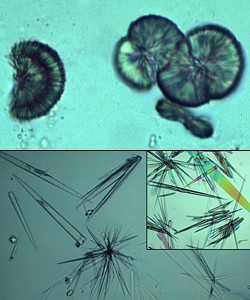|
Many drugs excreted in the urine have the potential to form crystals. Hence, a review of the
patients drug history is prudent when faced with unidentified urine crystals.
Most common among these are the sulfa drugs. Both panels on the right are from patients receiving trimethoprim-sulfadiazine. The differing appearance may relate to variation in drug concentration, urine pH, and other factors. The upper panel is from a feline case, the lower from a horse. The inset in the lower panel shows the crystals as they appeared when polarized. Other examples include radiopaque contrast agents (Hypaque, Renografin) and ampicillin which may precipitate in acid urine as fine needle-like crystals (not shown). |
 |
Last Updated: January 16, 1996